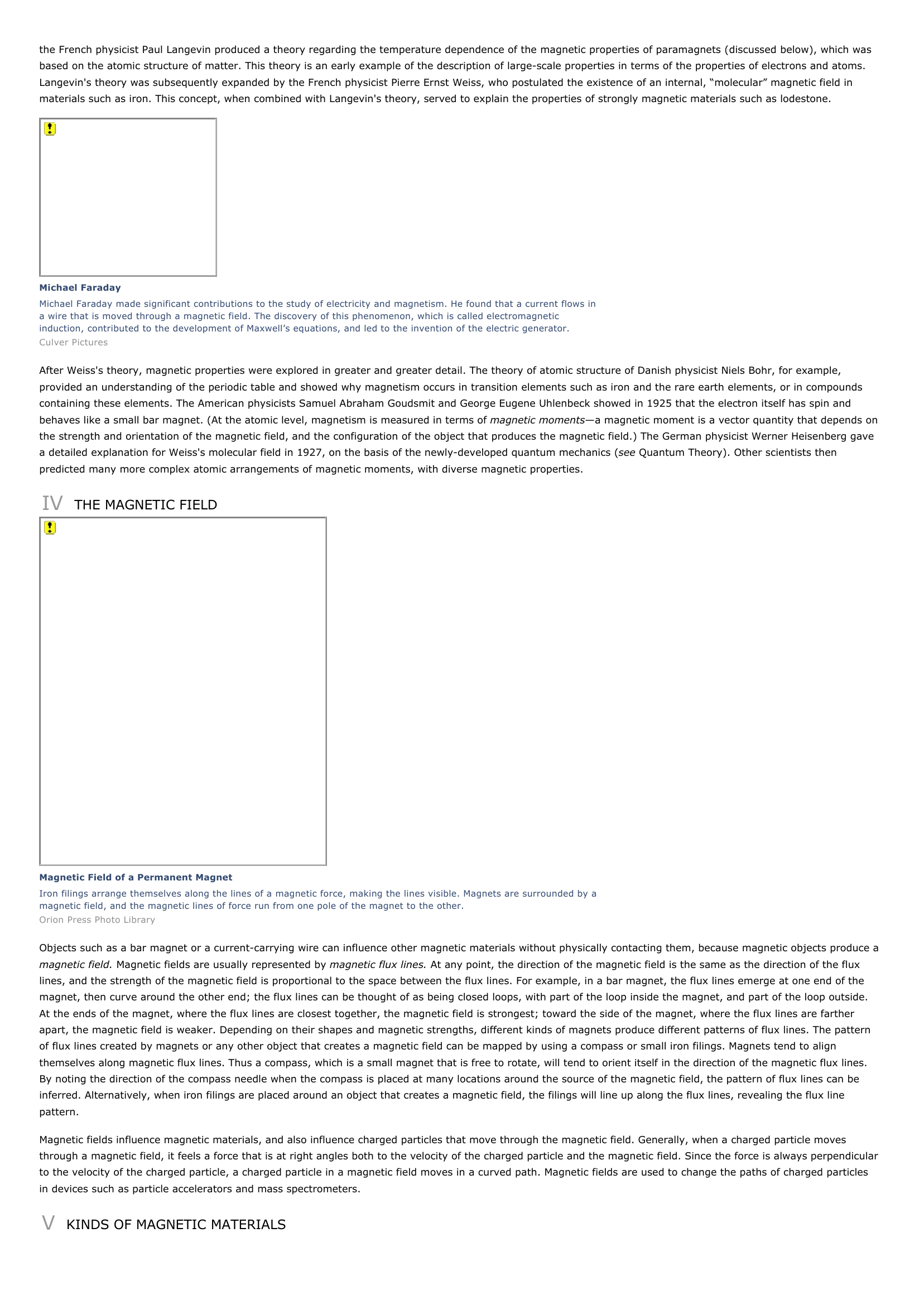Magnetism I INTRODUCTION Magnetism, an aspect of electromagnetism, one of the fundamental forces of nature.
Publié le 12/05/2013

Extrait du document
«
the French physicist Paul Langevin produced a theory regarding the temperature dependence of the magnetic properties of paramagnets (discussed below), which wasbased on the atomic structure of matter.
This theory is an early example of the description of large-scale properties in terms of the properties of electrons and atoms.Langevin's theory was subsequently expanded by the French physicist Pierre Ernst Weiss, who postulated the existence of an internal, “molecular” magnetic field inmaterials such as iron.
This concept, when combined with Langevin's theory, served to explain the properties of strongly magnetic materials such as lodestone.
Michael FaradayMichael Faraday made significant contributions to the study of electricity and magnetism.
He found that a current flows ina wire that is moved through a magnetic field.
The discovery of this phenomenon, which is called electromagneticinduction, contributed to the development of Maxwell’s equations, and led to the invention of the electric generator.Culver Pictures
After Weiss's theory, magnetic properties were explored in greater and greater detail.
The theory of atomic structure of Danish physicist Niels Bohr, for example,provided an understanding of the periodic table and showed why magnetism occurs in transition elements such as iron and the rare earth elements, or in compoundscontaining these elements.
The American physicists Samuel Abraham Goudsmit and George Eugene Uhlenbeck showed in 1925 that the electron itself has spin andbehaves like a small bar magnet.
(At the atomic level, magnetism is measured in terms of magnetic moments —a magnetic moment is a vector quantity that depends on the strength and orientation of the magnetic field, and the configuration of the object that produces the magnetic field.) The German physicist Werner Heisenberg gavea detailed explanation for Weiss's molecular field in 1927, on the basis of the newly-developed quantum mechanics ( see Quantum Theory).
Other scientists then predicted many more complex atomic arrangements of magnetic moments, with diverse magnetic properties.
IV THE MAGNETIC FIELD
Magnetic Field of a Permanent MagnetIron filings arrange themselves along the lines of a magnetic force, making the lines visible.
Magnets are surrounded by amagnetic field, and the magnetic lines of force run from one pole of the magnet to the other.Orion Press Photo Library
Objects such as a bar magnet or a current-carrying wire can influence other magnetic materials without physically contacting them, because magnetic objects produce amagnetic field. Magnetic fields are usually represented by magnetic flux lines. At any point, the direction of the magnetic field is the same as the direction of the flux lines, and the strength of the magnetic field is proportional to the space between the flux lines.
For example, in a bar magnet, the flux lines emerge at one end of themagnet, then curve around the other end; the flux lines can be thought of as being closed loops, with part of the loop inside the magnet, and part of the loop outside.At the ends of the magnet, where the flux lines are closest together, the magnetic field is strongest; toward the side of the magnet, where the flux lines are fartherapart, the magnetic field is weaker.
Depending on their shapes and magnetic strengths, different kinds of magnets produce different patterns of flux lines.
The patternof flux lines created by magnets or any other object that creates a magnetic field can be mapped by using a compass or small iron filings.
Magnets tend to alignthemselves along magnetic flux lines.
Thus a compass, which is a small magnet that is free to rotate, will tend to orient itself in the direction of the magnetic flux lines.By noting the direction of the compass needle when the compass is placed at many locations around the source of the magnetic field, the pattern of flux lines can beinferred.
Alternatively, when iron filings are placed around an object that creates a magnetic field, the filings will line up along the flux lines, revealing the flux linepattern.
Magnetic fields influence magnetic materials, and also influence charged particles that move through the magnetic field.
Generally, when a charged particle movesthrough a magnetic field, it feels a force that is at right angles both to the velocity of the charged particle and the magnetic field.
Since the force is always perpendicularto the velocity of the charged particle, a charged particle in a magnetic field moves in a curved path.
Magnetic fields are used to change the paths of charged particlesin devices such as particle accelerators and mass spectrometers.
V KINDS OF MAGNETIC MATERIALS.
»
↓↓↓ APERÇU DU DOCUMENT ↓↓↓
Liens utiles
- Physics I INTRODUCTION Physics, major science, dealing with the fundamental constituents of the universe, the forces they exert on one another, and the results produced by these forces.
- Comedy I INTRODUCTION Laurel and Hardy Stan Laurel, in overalls, and Oliver Hardy, left, formed one of the most popular comedy teams in motion-picture history.
- Musical I INTRODUCTION George Gershwin American pianist, songwriter, and composer George Gershwin was one of the most important figures in popular song in the 1920s and 1930s.
- Emily Dickinson I INTRODUCTION Emily Dickinson Heralded as one of the most gifted American writers, Emily Dickinson authored nearly 2,000 poems.
- Wolfgang Amadeus Mozart I INTRODUCTION Wolfgang Amadeus Mozart Wolfgang Amadeus Mozart, an 18th-century Austrian classical composer and one of the most famous musicians of all time, came from a family of musicians that included his father and sister.

































